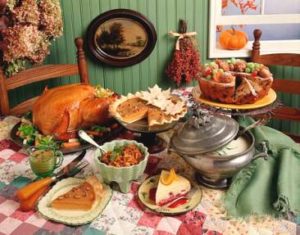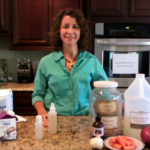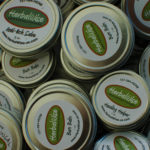 It is getting to be that time of year, some look forward to it, others dread it, but the holiday season is almost here. I thought it would be helpful to share some natural remedy tips that you may find useful as you prepare and indulge in Thanksgiving festivities.
It is getting to be that time of year, some look forward to it, others dread it, but the holiday season is almost here. I thought it would be helpful to share some natural remedy tips that you may find useful as you prepare and indulge in Thanksgiving festivities.
In this article:
Digestion
Kitchen Cuts & Burns
Cleaning Up
Digestion
To start, let’s discuss natural remedies for digestion. Thanksgiving is traditionally a day of making poor eating choices, particularly eating way too much. Using herbs to help digestion is a natural, gentle way to improve digestive functioning and prevent digestive problems.
The digestive action of herbs can be broadly grouped into two types of actions — digestive stimulants and digestive relaxants.
Digestive stimulants stimulate various parts of the system to increase or better activity. Stimulants include the following types of herbs:
Bitters – Most people have heard of digestive bitters, especially those who are prone to seasickness, but did you know that bitterness aids digestion? Herbal bitters can be used to treat upset stomach, excess fullness, or as a laxative. Take a spoonful before a meal to promote digestion . A few of the most valuable ones are Barberry, Goldenseal, and Wormwood.
Sialagogues – The importance of saliva cannot be overstressed. It breaks down carbohydrates so they are processed easier. Make sure to take time to chew your food. Besides bitters, which are all sialagogues, others include Cayenne, Ginger, Licorice, Tamarind, and Turkey Rhubarb Root.
Hepatics – Hepatics strengthen, tone and stimulate the function of the liver to increase the flow of bile. The liver is involved in all body functions and the health of all tissues. Some of the most useful hepatic herbs available to us include Barberry, Dandelion Root, Goldenseal, Vervain, Wild Yam and Yellow Dock.
Laxatives and Evacuants – The best laxatives are those that stimulate the natural secretion of digestive juices. Some of these include Barberry, Dandelion Root, Licorice, and Yellow Dock and Rhubarb Root. Others to consider are Aloe Vera, Cascara Sagrada and Senna. Use these with caution as they work mainly by chemical or neurological stimulation causing an active expulsion of material.
Digestive relaxants relax the tissue or reduce any over-activity in the system. Digestive relaxants include the following types of herbs:
Demulcents – Demulcent herbs soothe and protect inflamed membranes of the digestive tract. They can be helpful if you suffer from acid reflux or GERD. Some the most effective demulcents for the digestive system include Hops, Marshmallow Root, Oats, and Slippery Elm.
Carminatives – These aromatic herbs contain volatile oils that relax the stomach muscles, increasing the movement of the intestine and reducing production of the all too common Thanksgiving symptoms of gas and bloating. Some of the best carminatives are commonly used in cooking and include Aniseed, Caraway, Cardamom, Cayenne, Chamomile, Coriander, Fennel, Ginger, Peppermint and Thyme.
Astringents – Astringents contract cell walls condensing the tissue and making it firmer and stopping unwanted discharge. This is helpful for IBS symptoms like diarrhea. Astringents suitable for the digestive system include Bayberry, Meadowsweet, and Nettles.
Anti-spasmodics – Anti-spasmodics are remedies that rapidly relax nervous tension that may be causing digestive spasms. The best ones to use in cases of digestive problems are Chamomile, Hops, Skullcap, and Valerian.
Kitchen Injuries – Cuts & Burns
If you are like me, it is inevitable that at some point you will either knick a finger with a knife or burn yourself on the oven or a hot pan when preparing your Thanksgiving feast. Here are some natural remedies to help with these situations.
Disinfectant: Thyme, garlic, lavender, and others can be made into a tea to disinfect cuts.
Styptic (stop bleeding): sprinkling powdered cayenne or peppermint leaf on a cut will stop bleeding. As will a Yarrow leaf poultice. The Chinese herb Tian Qi is also good to stop bleeding.
Healing salve: Also known as a balm or ointment, you want a salve that is antiseptic, speeds healing, soothes inflamed tissues. Plantain, St John’s wort, Lavender, Thyme, Comfrey and Calendula combinations of these can be included in the salve.
Aloe vera gel: Cooling and healing, aloe vera (Aloe vera) soothes the inflammation common kitchen scalds and burns.
Burns: Immediately immerse the affected area in cold water until the burning sensation subsides. Then apply aloe vera gel mixed with lavender essential oil (5 drops of lavender oil mixed with 1 tablespoon of aloe vera gel). St John’s Wort and Comfrey are also good for burns. A soak of black tea (high in tannins) is good for burns also.
Cleaning Up
After all the preparations and eating, comes clean-up time. There are many benefits to using natural ways of cleaning, some of these benefits include Less packaging waste: You’re not buying new bottles over and over; lower cost; and they are less harmful (often not harmful at all) to humans, animals, and the earth. Here are a few natural cleaning tips to ease the load on your Thanksgiving holiday:
Water spots – Add a cup of white distilled vinegar to your dishwasher, or soak ½ cup vinegar in a 1 gallon of water to clear water spots or white film on your glasses.
Scrubbing Pots – Add Baking Soda to your rag, sponge or brush. It is non-abrasive and works great.
Removing a Fresh Red Wine Stain – It is easiest to remove red wine when it is still wet. Begin by blotting with a clean cloth to remove as much of the wine as possible. It’s very important to BLOT throughout this entire process DO NOT SCRUB. Working from the outside of the stain towards the center will keep the stain from spreading. Dab the stain with white wine and blot with a clean cloth. If the stain still remains, try dabbing a little bit of club soda on the stain and blot to remove. If the stain still persists, try pouring either salt or baking soda on the stain and letting it set. The powder should soak up the stain and remove it.
These techniques should be safe for most washable fabrics, but be sure to test a small, inconspicuous spot to ensure there is no discoloring or damage to the fabric fibers. If the stain is on a garment that is dry-clean only, do not pre-treat or attempt to remove the stain. Take the item to a professional cleaner as soon as possible to have the stain treated.
How to Remove a Grease or Oil Stain from Fabric – The key to all of these tips is to treat the stain as quickly as possible. The longer you leave it, the tougher it is to remove.
Cornstarch and Dish Soap —Lay your item of clothing on a flat surface and liberally sprinkle cornstarch over the stain. Let that soak in for at least 30 minutes, but one hour is preferable. Next, rub dish soap into the stain. Finally, wash using the directions on the care label and air dry.
Hair Spray —Spray the oil or grease stain liberally with hair spray; it should take most of it out instantly. Then, wash and air dry.
Shampoo — Shampoo is designed to get grease and natural oils out of your hair, so why not other fabrics? Just rub it into the stain like a pre-treatment. Then wash as directed.
I hope you find these tips helpful and that you have a wonderful Thanksgiving!
Learn more by signing up for my online course “Natural Remedies for Everyday Living” 



Recent Comments